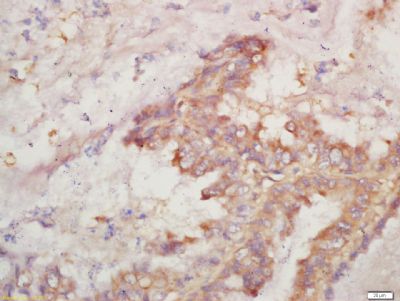
phospho-CTNNA1 (Ser641),磷酸化α-连环蛋白抗体
产品名称: phospho-CTNNA1 (Ser641),磷酸化α-连环蛋白抗体
英文名称: Anti-phospho-CTNNA1 (Ser641) antibody
产品编号: HZ-5280R
产品价格: null
产品产地: 中国/美国
品牌商标: HZbscience
更新时间: 2023-08-17T10:24:20
使用范围: WB,ELISA,IHC-P,IHC-F,IF
- 联系人 : 鲍丽雯
- 地址 : 上海市闵行区闵北路88弄1-30号第22幢AQ136室
- 邮编 : 200612
- 所在区域 : 上海
- 电话 : 139****0749 点击查看
- 传真 : 点击查看
- 邮箱 : www.shzbio.net
- 二维码 : 点击查看
phospho-CTNNA1 (Ser641),磷酸化α-连环蛋白抗体
产品编号HZ-5280R
英文名称phospho-CTNNA1 (Ser641)
中文名称磷酸化α-连环蛋白抗体
别 名p-CTNNA1 (Ser641); CTNNA1 (phospho-Ser641); CTNNA1 (phospho-S641); alpha 1 Catenin (phospho S641); alpha catenin; alpha E catenin; alphaE catenin; Cadherin associated protein 102kDa; Cadherin associated protein; CAP 102; CAP102; Catenin (cadherin associated protein) alpha 1 102kDa; Catenin alpha 1; CTNNA 1; CTNNA1; Alpha-cats; FLJ36832; NY REN 13 antigen; CTNA1_HUMAN.
说 明 书0.1ml
产品类型磷酸化抗体
研究领域肿瘤 细胞生物 免疫学 信号转导 干细胞 细胞粘附分子 细胞骨架
抗体来源Rabbit
克隆类型Polyclonal
交叉反应Human, Mouse, Rat, Chicken, Dog, Pig, Cow, Horse, Rabbit, Sheep,
phospho-CTNNA1 (Ser641),磷酸化α-连环蛋白抗体产品应用WB=1:100-500 ELISA=1:500-1000 IHC-P=1:100-500 IHC-F=1:100-500 IF=1:100-500 (石蜡切片需做抗原修复)
not yet tested in other applications.
optimal dilutions/concentrations should be determined by the end user.
分 子 量100kDa
细胞定位细胞浆 细胞膜
性 状Lyophilized or Liquid
浓 度1mg/1ml
免 疫 原KLH conjugated Synthesised phosphopeptide derived from human CTNNA1 around the phosphorylation site of Ser641 [DD(p-S)DF]
亚 型IgG
纯化方法affinity purified by Protein A
储 存 液0.01M TBS(pH7.4) with 1% BSA, 0.03% Proclin300 and 50% Glycerol.
保存条件Store at -20 °C for one year. Avoid repeated freeze/thaw cycles. The lyophilized antibody is stable at room temperature for at least one month and for greater than a year when kept at -20°C. When reconstituted in sterile pH 7.4 0.01M PBS or diluent of antibody the antibody is stable for at least two weeks at 2-4 °C.
phospho-CTNNA1 (Ser641),磷酸化α-连环蛋白抗体PubMedPubMed
产品介绍background:
The distinct peripheral cytosolic proteins, alpha, beta and gamma-catenin (102, 94 and 86 kDa) found in many tissues bind to the conserved cytoplasmic tail domain of the cell-adhesion cadherins. Catenins link E-cadherin to other integral membrane or cytoplasmic proteins and are modulated by Wnt-1 proto-oncogene. They are good candidates for mediating transduction of cell-cell contact positional signals to the cell interior. Absence of alpha-catenin is found in certain tumor cell lines and reduced levels in certain human carcinomas. Beta-catenin binds directly to the cytoplasmic tail of E-cadherin. It binds to the N-terminus of alpha-catenin and interacts with the protein product of the tumor suppressor gene APC. This interaction involves a 15-aa repeat in the APC. Beta-catenin cell levels seem to be controlled by APC. The central core region of beta-catenin is involved in mediation of cadherin-catenin complex interaction with EGFR.
Function:
Associates with the cytoplasmic domain of a variety of cadherins. The association of catenins to cadherins produces a complex which is linked to the actin filament network, and which seems to be of primary importance for cadherins cell-adhesion properties. Can associate with both E- and N-cadherins. Originally believed to be a stable component of E-cadherin/catenin adhesion complexes and to mediate the linkage of cadherins to the actin cytoskeleton at adherens junctions. In contrast, cortical actin was found to be much more dynamic than E-cadherin/catenin complexes and CTNNA1 was shown not to bind to F-actin when assembled in the complex suggesting a different linkage between actin and adherens junctions components. The homodimeric form may regulate actin filament assembly and inhibit actin branching by competing with the Arp2/3 complex for binding to actin filaments. May play a crucial role in cell differentiation.
phospho-CTNNA1 (Ser641),磷酸化α-连环蛋白抗体Subunit:
Monomer and homodimer; the monomer preferentially binds to CTNNB1 and the homodimer to actin. Binds MLLT4 and F-actin. Possible component of an E-cadherin/ catenin adhesion complex together with E-cadherin/CDH1 and beta-catenin/CTNNB1 or gamma-catenin/JUP; the complex is located to adherens junctions. The stable association of CTNNA1 is controversial as CTNNA1 was shown not to bind to F-actin when assembled in the complex. Alternatively, the CTNNA1-containing complex may be linked to F-actin by other proteins such as LIMA1. Interacts with ARHGAP21 and with AJUBA. Interacts with LIMA1.
Subcellular Location:
Cytoplasm, cytoskeleton. Cell junction, adherens junction. Cell membrane; Peripheral membrane protein; Cytoplasmic side. Cell junction. Note=Found at cell-cell boundaries and probably at cell-matrix boundaries.
Tissue Specificity:
Expressed ubiquitously in normal tissues.
Post-translational modifications:
Sumoylated.
Similarity:
Belongs to the vinculin/alpha-catenin family.
Database links:
UniProtKB/Swiss-Prot: P35221.1
Important Note:
This product as supplied is intended for research use only, not for use in human, therapeutic or diagnostic applications.
α-catenin是一种多功能的蛋白质,能链接E-\N-\P-钙粘附分子,具有参与细胞粘附和介导信号转导的双重功能,并与肿瘤的发生发展及浸润密切相关。 在正常个体中,βα-catenin和钙黏蛋白形成复合体,介导同型细胞的粘附,维持细胞的稳定;同时,α-catenin作为Wnt/α-catenin信号通路的关键成员在介导信号转导过程中调控细胞的增殖和凋亡。 在恶性肿瘤中,α-catenin的表达呈现明显的异质性,促使细胞异常增殖,还可使细胞之间的黏附性减弱,侵袭性增强。

